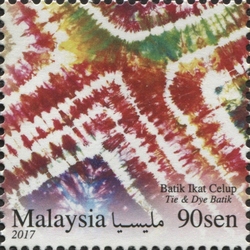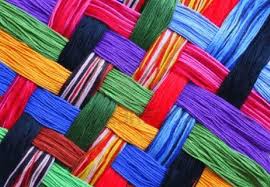Stamp: Malaysian Batik (Malaysia 2017)
Malaysian Batik (Malaysia 2017)
20 June (Malaysia ) within release Malaysian Batik goes into circulation Stamp Malaysian Batik face value 0.90 Malaysian ringgit
| Stamp Malaysian Batik in catalogues | |
|---|---|
| WADP Numbering System - WNS: | WAD:MY044.17 |
Stamp is square format.
Number in set - 8||(show set). Layout - sheet of 20. Issuing - POS Malaysia. Printer - Southern Colour Print New ZealandAlso in the issue Malaysian Batik:
- Stamp - Malaysian Batik face value 0.60;
- Stamp - Malaysian Batik face value 0.60;
- Stamp - Malaysian Batik face value 0.80;
- Stamp - Malaysian Batik face value 0.80;
- Stamp - Malaysian Batik face value 0.90;
- Stamp - Malaysian Batik face value 0.90;
- Stamp - Malaysian Batik face value 3.00;
- Stamp - Malaysian Batik face value 3.00;
- Mini Sheet - Malaysian Batik face value ;
- Stamp - Batik Block - Design face value 60;
- Stamp - Batik Block - Stamping face value 60;
- Stamp - Metal Block face value 3;
- Stamp - Canting Batik - Melted Wax On Fabric face value 80;
- Stamp - Tie & Dye Batik - Design face value 90;
- Stamp - Tie & Dye Batik face value 90;
- Stamp - Canting Batik - Design face value 80;
- Souvenir Sheet - Metal Block & Wood Block face value 2*3;
- Stamp - Wood Block face value 3;
|
Data entry completed
83%
|
|
|---|---|
| Stamp Malaysian Batik in digits | |
| Country: | Malaysia |
| Date: | 2017-06-20 |
| Size: | 30 x 30 |
| Perforation: | 14 by 14 |
| Format: | Stamp |
| Face Value: | 0.90 Malaysian ringgit |
Stamp Malaysian Batik it reflects the thematic directions:
Humans (Homo sapiens, meaning "thinking man") or modern humans are the most common and widespread species of primate, and the last surviving species of the genus Homo. They are great apes characterized by their hairlessness, bipedalism, and high intelligence. Humans have large brains, enabling more advanced cognitive skills that enable them to thrive and adapt in varied environments, develop highly complex tools, and form complex social structures and civilizations. Humans are highly social, with individual humans tending to belong to a multi-layered network of cooperating, distinct, or even competing social groups – from families and peer groups to corporations and political states. As such, social interactions between humans have established a wide variety of values, social norms, languages, and traditions (collectively termed institutions), each of which bolsters human society. Humans are also highly curious, with the desire to understand and influence phenomena having motivated humanity's development of science, technology, philosophy, mythology, religion, and other frameworks of knowledge; humans also study themselves through such domains as anthropology, social science, history, psychology, and medicine. There are estimated to be more than eight billion living humans.
Costume is the distinctive style of dress and/or makeup of an individual or group that reflects class, gender, occupation, ethnicity, nationality, activity or epoch—in short, culture.
Textile is an umbrella term that includes various fiber-based materials, including fibers, yarns, filaments, threads, different fabric types, etc. At first, the word "textiles" only referred to woven fabrics. However, weaving is not the only manufacturing method, and many other methods were later developed to form textile structures based on their intended use. Knitting and non-woven are other popular types of fabric manufacturing. In the contemporary world, textiles satisfy the material needs for versatile applications, from simple daily clothing to bulletproof jackets, spacesuits, and doctor's gowns.
In European academic traditions, fine art is made primarily for aesthetics or creative expression, distinguishing it from decorative art or applied art, which also has to serve some practical function, such as pottery or most metalwork. In the aesthetic theories developed in the Italian Renaissance, the highest art was that which allowed the full expression and display of the artist's imagination, unrestricted by any of the practical considerations involved in, say, making and decorating a teapot. It was also considered important that making the artwork did not involve dividing the work between different individuals with specialized skills, as might be necessary with a piece of furniture, for example. Even within the fine arts, there was a hierarchy of genres based on the amount of creative imagination required, with history painting placed higher than still life.


